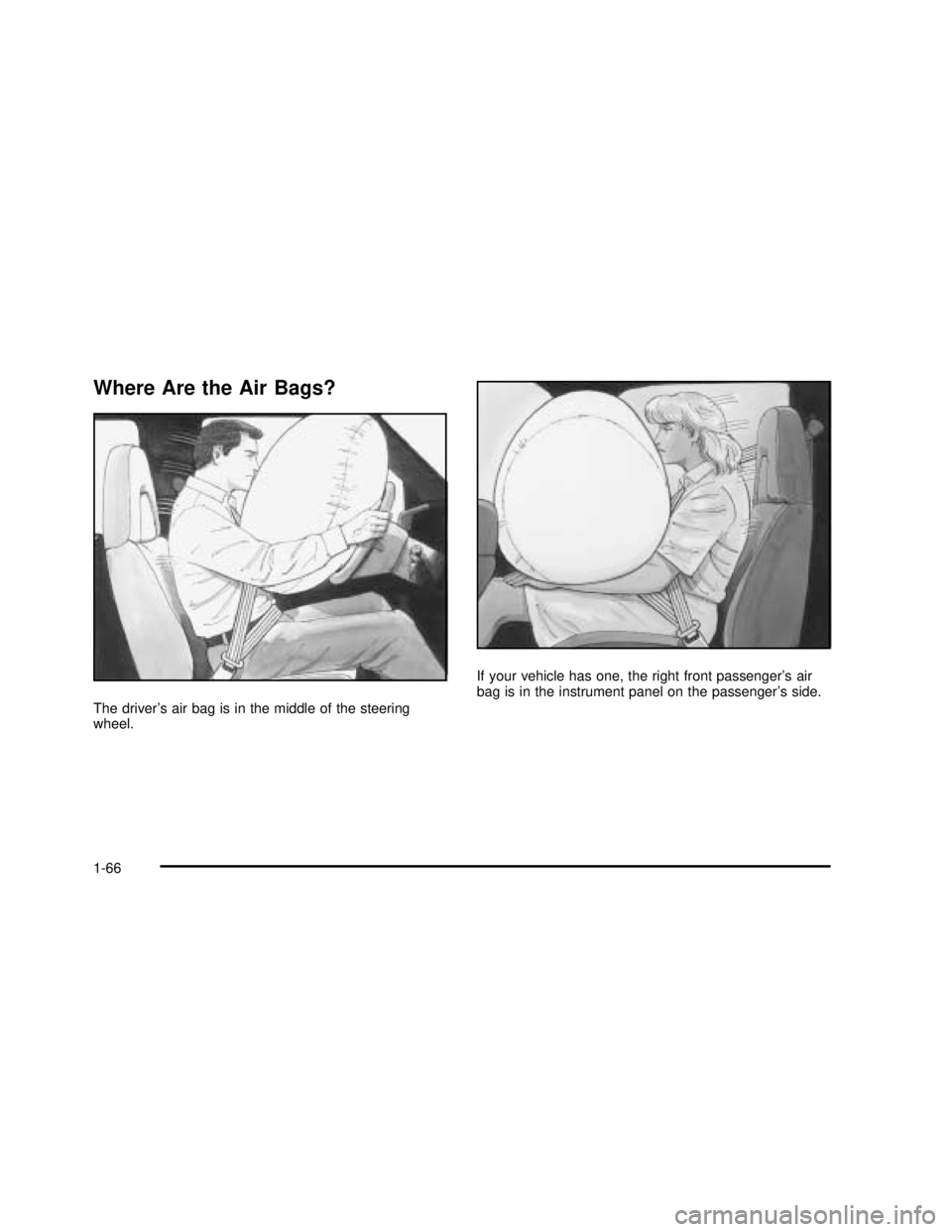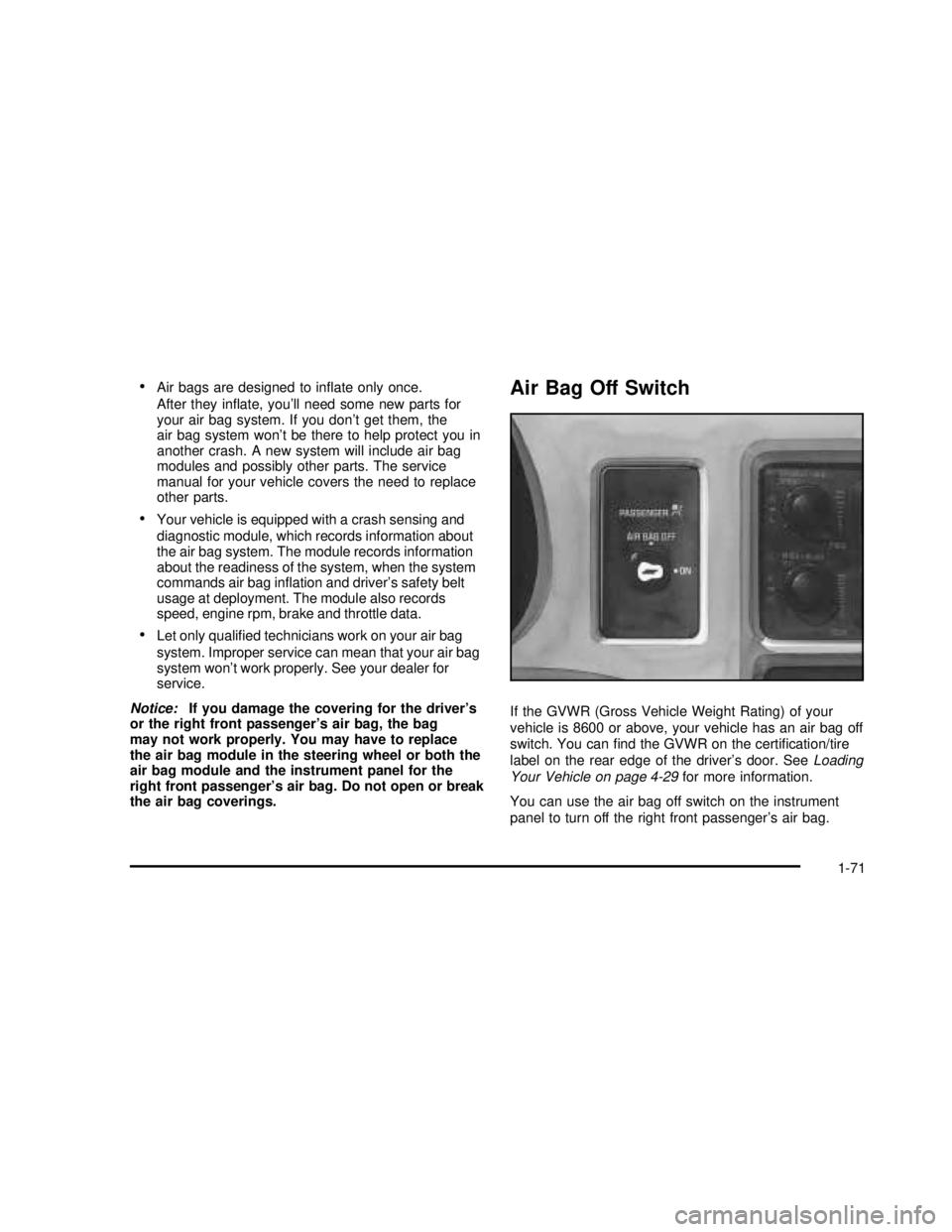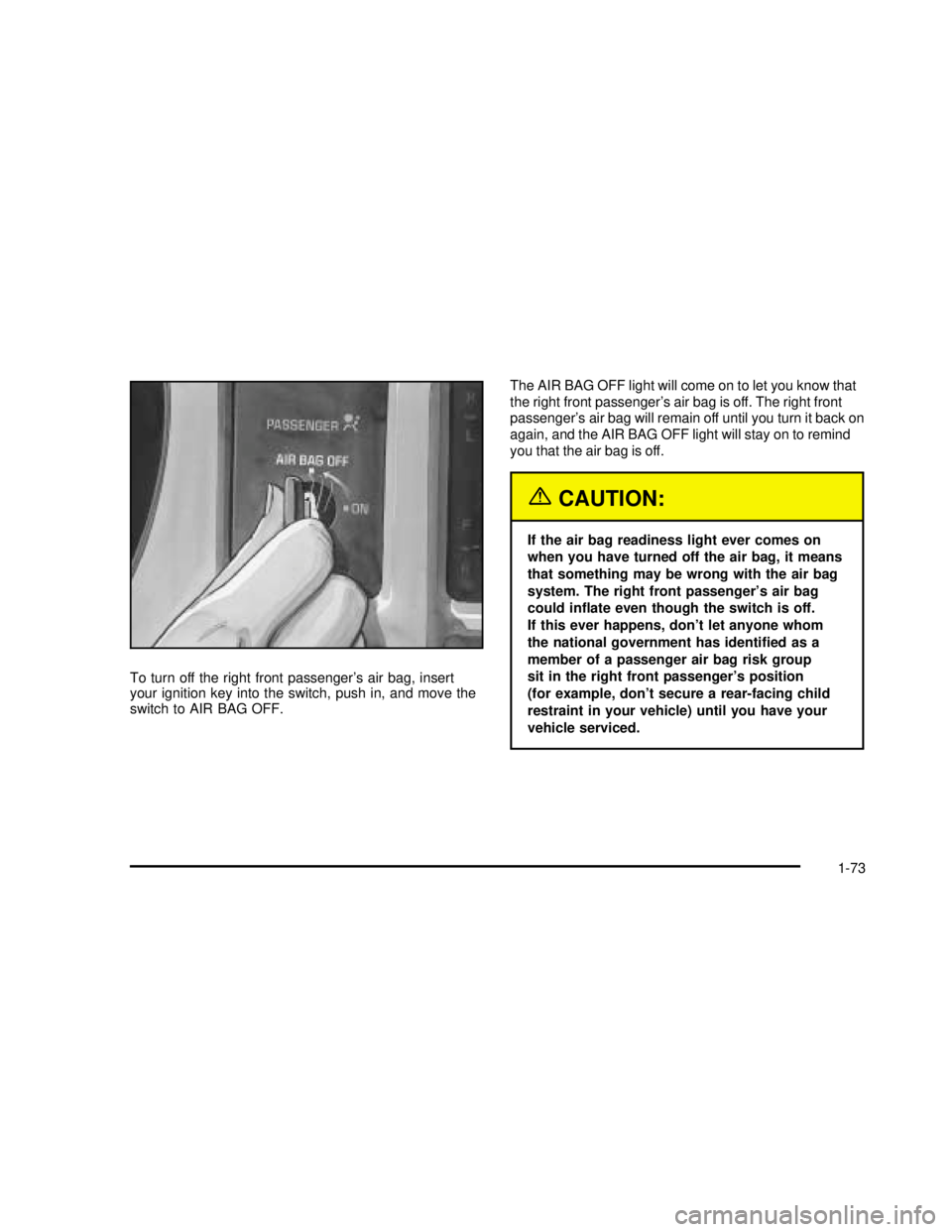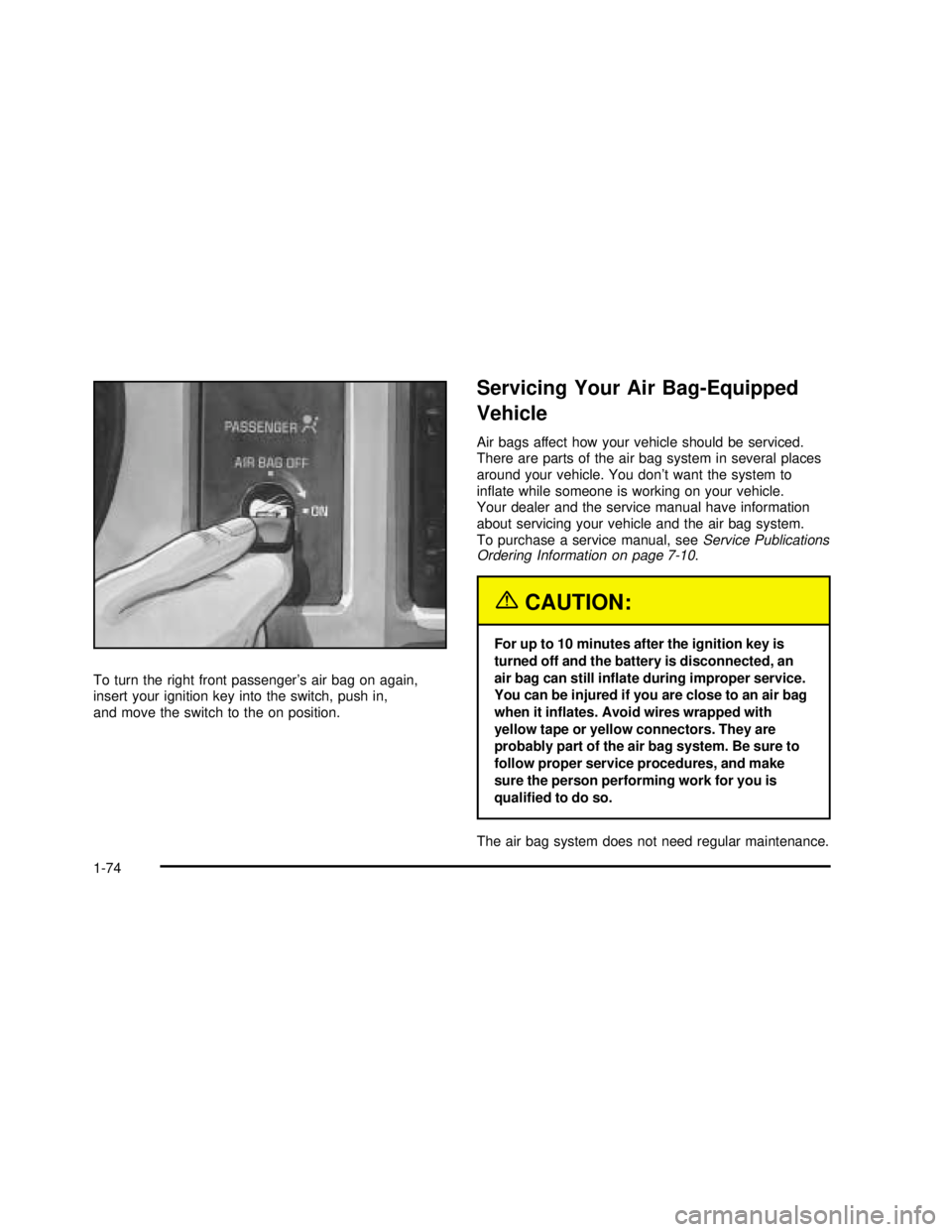GMC SAVANA 2003 Manual PDF
Manufacturer: GMC, Model Year: 2003, Model line: SAVANA, Model: GMC SAVANA 2003Pages: 392, PDF Size: 2.34 MB
Page 71 of 392

If your vehicle has an air bag for the right front
passenger read this.
{CAUTION:
Anyone who is up against, or very close to,
any air bag when it inflates can be seriously
injured or killed. Air bags plus lap-shoulder
belts offer the best protection for adults, but
not for young children and infants. Neither the
vehicle’s safety belt system nor its air bag
system is designed for them. Young children
and infants need the protection that a child
restraint system can provide. Always secure
children properly in your vehicle. To read how,
see the parts of this manual called “Older
Children” and “Infants and Young Children”.There is a air bag
readiness light on the
instrument panel, which
shows the air bag symbol.
The system checks the air bag electrical system for
malfunctions. The light tells you if there is an electrical
problem. SeeAir Bag Readiness Light on page 3-27
for more information.
1-65
2003 - Savana OM
Page 72 of 392

Where Are the Air Bags?
The driver’s air bag is in the middle of the steering
wheel.If your vehicle has one, the right front passenger’s air
bag is in the instrument panel on the passenger’s side.
1-66
2003 - Savana OM
Page 73 of 392

{CAUTION:
If something is between an occupant and an
air bag, the bag might not inflate properly or it
might force the object into that person causing
severe injury or even death. The path of an
inflating air bag must be kept clear. Don’t put
anything between an occupant and an air bag,
and don’t attach or put anything on the steering
wheel hub or on or near any other air bag
covering.
When Should an Air Bag Inflate?
An air bag is designed to inflate in a moderate to severe
frontal, or near-frontal crash. The air bag will inflate
only if the impact speed is above the system’s designed
“threshold level.”
If the GVWR (Gross Vehicle Weight Rating) of your
vehicle is 8600 or above, your vehicle has single stage air
bags. If the GVWR is below 8600 then your vehicle has
dual stage air bags. You canfind the GVWR on the
certification label on the rear edge of the driver’s door.
SeeLoading Your Vehicle on page 4-29for more
information.
1-67
2003 - Savana OM
Page 74 of 392

Single Stage Air Bags
If your vehicle has frontal air bags with single stage
deployment and your vehicle goes straight into a wall
that doesn’t move or deform, the threshold level is about
9 to 16 mph (14 to 26 km/h). The threshold level can
vary, however, with specific vehicle design, so that it
can be somewhat above or below this range. If your
vehicle strikes something that will move or deform,
such as a parked car, the threshold level will be higher.
The air bag is not designed to inflate in rollovers,
rear impacts, or in many side impacts because inflation
would not help the occupant.
In any particular crash, no one can say whether an air
bag should have inflated simply because of the damage
to a vehicle or because of what the repair costs were.
Inflation is determined by the angle of the impact
and how quickly the vehicle slows down in frontal or
near-frontal impacts.
Dual Stage Air Bags
If your vehicle has frontal air bags with dual stage
deployment, the amount of restraint will adjust according
to the crash severity. For moderate frontal impacts,
these air bags inflate at a level less than full deployment.
For more severe frontal impacts, full deployment
occurs. If the front of your vehicle goes straight into a
wall that doesn’t move or deform, the threshold level
for the reduced deployment is about 12 to 16 mph
(19 to 26 km/h), and the threshold level for a full
deployment is about 16 to 25 mph (26 to 40 km/h).
The threshold level can vary, however, with specific
vehicle design, so that it can be somewhat above
or below this range.
If your vehicle strikes something that will move or
deform, such as a parked car, the threshold level will be
higher. The driver’s and right front passenger’s frontal
air bags are not designed to inflate in rollovers, rear
impacts, or many side impacts because inflation would
not help the occupant.
1-68
2003 - Savana OM
Page 75 of 392

Seat Position Sensors
Vehicles with dual stage air bags are also equipped with
special sensors which enable the sensing system to
monitor the position of both the driver and passenger
front seats. The seat position sensors provide
information which is used to determine if the air bags
should deploy at a reduced level or at full depoyment.
Air Bag Systems
In any particular crash, no one can say whether an air
bag should have inflated simply because of the damage
to a vehicle or because of what the repair costs were.
Inflation is determined by the angle of the impact
and how quickly the vehicle slows down in front or
near-frontal impacts.
What Makes an Air Bag Inflate?
In an impact of sufficient severity, the air bag sensing
system detects that the vehicle is in a crash. The sensing
system triggers a release of gas from the inflator, which
inflates the air bag. The inflator, air bag, and related
hardware are all part of the air bag modules inside the
steering wheel and in the instrument panel in front of the
right front passenger.
HowDoes an Air Bag Restrain?
In moderate to severe frontal or near-frontal collisions,
even belted occupants can contact the steering wheel
or the instrument panel. Air bags supplement the
protection provided by safety belts. Air bags distribute
the force of the impact more evenly over the occupant’s
upper body, stopping the occupant more gradually.
But air bags would not help you in many types of
collisions, including rollovers, rear impacts and many
side impacts, primarily because an occupant’s motion is
not toward those air bags. Air bags should never be
regarded as anything more than a supplement to safety
belts, and then only in moderate to severe frontal or
near-frontal collisions.
1-69
2003 - Savana OM
Page 76 of 392

What Will You See After an
Air Bag Inflates?
After an air bag inflates, it quickly deflates, so quickly that
some people may not even realize the air bag inflated.
Some components of the air bag module–the steering
wheel hub for the driver’s air bag, or the instrument panel
for the right front passenger’s bag–will be hot for a short
time. The parts of the bag that come into contact with you
may be warm, but not too hot to touch. There will be
some smoke and dust coming from the vents in the
deflated air bags. Air bag inflation doesn’t prevent the
driver from seeing or being able to steer the vehicle,
nor does it stop people from leaving the vehicle.
{CAUTION:
When an air bag inflates, there is dust in the air.
This dust could cause breathing problems
for people with a history of asthma or other
breathing trouble. To avoid this, everyone in the
vehicle should get out as soon as it is safe to
doso. If you have breathing problems but can’t
get out of the vehicle after an air bag inflates,
then get fresh air by opening a window or a
door.If you experience breathing problems
following an air bag deployment, you should
seek medical attention.
1-70
2003 - Savana OM
Page 77 of 392

•Air bags are designed to inflate only once.
After they inflate, you’ll need some new parts for
your air bag system. If you don’t get them, the
air bag system won’t be there to help protect you in
another crash. A new system will include air bag
modules and possibly other parts. The service
manual for your vehicle covers the need to replace
other parts.
•Your vehicle is equipped with a crash sensing and
diagnostic module, which records information about
the air bag system. The module records information
about the readiness of the system, when the system
commands air bag inflation and driver’s safety belt
usage at deployment. The module also records
speed, engine rpm, brake and throttle data.
•Let only qualified technicians work on your air bag
system. Improper service can mean that your air bag
system won’t work properly. See your dealer for
service.
Notice:If you damage the covering for the driver’s
or the right front passenger’s air bag, the bag
may not work properly. You may have to replace
the air bag module in the steering wheel or both the
air bag module and the instrument panel for the
right front passenger’s air bag. Do not open or break
the air bag coverings.
Air Bag Off Switch
If the GVWR (Gross Vehicle Weight Rating) of your
vehicle is 8600 or above, your vehicle has an air bag off
switch. You canfind the GVWR on the certification/tire
label on the rear edge of the driver’s door. SeeLoading
Your Vehicle on page 4-29for more information.
You can use the air bag off switch on the instrument
panel to turn off the right front passenger’s air bag.
1-71
2003 - Savana OM
Page 78 of 392

This switch should only be turned to AIR BAG OFF if
the person in the right front passenger’s position is
a member of a passenger risk group identified by the
national government as follows:
Infant.An infant (less than 1 year old) must
ride in the front seat because:
•
my vehicle has no rear seat;
•my vehicle has a rear seat too small to
accommodate a rear-facing infant seat; or
•the infant has a medical condition which, according
to the infant’s physician, makes it necessary for the
infant to ride in the front seat so that the driver
can constantly monitor the child’s condition.
Child age 1 to 12.A child age 1 to 12 must
ride in the front seat because:
•
my vehicle has no rear seat;
•although children ages 1 to 12 ride in the rear seat(s)
whenever possible, children ages 1 to 12 sometimes
must ride in the front because no space is available
in the rear seat(s) of my vehicle; or
•the child has a medical condition which, according to
the child’s physician, makes it necessary for the child
to ride in the front seat so that the driver can
constantly monitor the child’s condition.
Medical Condition.A passenger has a
medical condition which, according to his or
her physician:
•
causes the passenger air bag to pose a special risk
for the passenger; and
•makes the potential harm from the passenger air
bag in a crash greater than the potential harm
from turning off the air bag and allowing the
passenger, even if belted, to hit the dashboard or
windshield in a crash.
{CAUTION:
If the right front passenger’s air bag is turned
off for a person who isn’t in a risk group
identified by the national government, that
person won’t have the extra protection of an
air bag. In a crash, the air bag wouldn’t be able
to inflate and help protect the person sitting
there. Don’t turn off the passenger’s air bag
unless the person sitting there is in a risk
group. See “Air Bag Off Switch” in the Index.
1-72
2003 - Savana OM
Page 79 of 392

To turn off the right front passenger’s air bag, insert
your ignition key into the switch, push in, and move the
switch to AIR BAG OFF.The AIR BAG OFF light will come on to let you know that
the right front passenger’s air bag is off. The right front
passenger’s air bag will remain off until you turn it back on
again, and the AIR BAG OFF light will stay on to remind
you that the air bag is off.
{CAUTION:
If the air bag readiness light ever comes on
when you have turned off the air bag, it means
that something may be wrong with the air bag
system. The right front passenger’s air bag
could inflate even though the switch is off.
If this ever happens, don’t let anyone whom
the national government has identified as a
member of a passenger air bag risk group
sit in the right front passenger’s position
(for example, don’t secure a rear-facing child
restraint in your vehicle) until you have your
vehicle serviced.
1-73
2003 - Savana OM
Page 80 of 392

To turn the right front passenger’s air bag on again,
insert your ignition key into the switch, push in,
and move the switch to the on position.
Servicing Your Air Bag-Equipped
Vehicle
Air bags affect how your vehicle should be serviced.
There are parts of the air bag system in several places
around your vehicle. You don’t want the system to
inflate while someone is working on your vehicle.
Your dealer and the service manual have information
about servicing your vehicle and the air bag system.
To purchase a service manual, seeService Publications
Ordering Information on page 7-10.
{CAUTION:
For up to 10 minutes after the ignition key is
turned off and the battery is disconnected, an
air bag can still inflate during improper service.
You can be injured if you are close to an air bag
when it inflates. Avoid wires wrapped with
yellow tape or yellow connectors. They are
probably part of the air bag system. Be sure to
follow proper service procedures, and make
sure the person performing work for you is
qualified to do so.
The air bag system does not need regular maintenance.
1-74
2003 - Savana OM